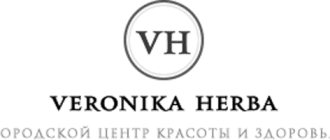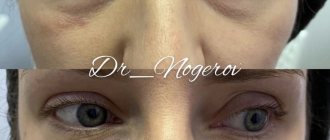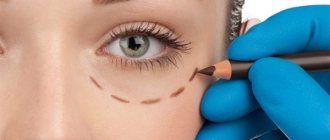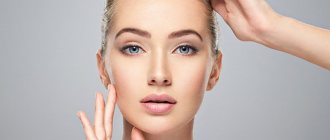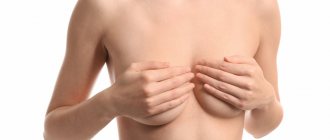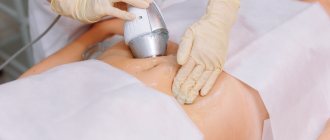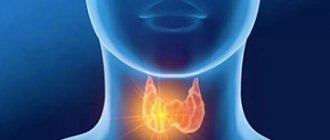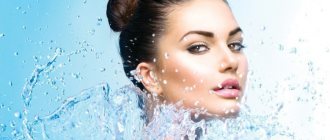- What is the nasolacrimal trough?
- Prevention
- Indications for correction
- How to eliminate a nasolacrimal trough
- What fillers are used to correct the nasolacrimal trough?
- Advantages
- Contraindications
- How does the procedure work?
- Rehabilitation
Along with the well-known signs of aging, such as wrinkles, there are also less obvious signs of age. One of them is a pronounced nasolacrimal groove. This defect can be eliminated in one visit to the clinic using filler injections.
What is the nasolacrimal trough?
This is the name of the line separating the periorbital region from the buccal-zygomatic region. The groove starts from the inner corner of the eye and goes down to the cheekbone and then to the temple. The skin in this area is especially thin, delicate and dry, prone to early wilting.
Usually in youth the nasolacrimal groove is invisible due to the elasticity and good moisture of the tissues. With age, the skin stretches, shadows appear under the eyes, wrinkles appear, and due to a lack of subcutaneous fat, the eyes may look sunken.
The severity of the nasolacrimal groove depends not only on age, but also on the structural features of the face, but this defect always visually adds extra age.
Age-related changes and structural features are not the only reasons for the appearance of a defect. Stress, lack of sleep, dieting, weight changes and poor nutrition, endocrine diseases and bad habits also play a role.
How to remove: is tear trough correction worth it?
The salons offer different procedures. The nasolacrimal trough can be removed both surgically and non-surgically. Let's talk about some of them.
First surgical:
- Surgical lipofilling.
It is carried out if the culprits for the manifestation of the nasolacrimal trench are low skin tone and “fat gaps”. This procedure is recommended for younger patients because they do not yet have the characteristic signs of ptosis or other cosmetic defects. Lipofilling is the transfer of adipose tissue from one area to another. In this case, fatty tissue is taken from the abdomen or thighs and filled into the nasal tear.After any such procedure, hematomas, swelling and scars appear. If the insertion technique has been violated, then clumping and unevenness are added. There is also pain in both the fat harvesting area and the receiving area. After some time, due to the individual characteristics of the body, this adipose tissue is absorbed. So, is it worth going through this procedure at all?
There is a similar procedure - injection lipofilling. The only difference is that in the case of surgical lipofilling, adipose tissue is introduced under the skin through an incision, and in the case of injections, through punctures with cannulas (special needles).
- Blepharoplasty.
Surgeons advise doing this procedure if, in addition to severe nasal tears, there is also a drooping eyelid, hernia of the lower eyelid and wrinkles. Blepharoplasty is usually performed to remove wrinkles and swelling, and nasal tears are a bonus. How the procedure works: soft tissues are cut out and redistributed. They promise that the effect will last for several years. Maybe that's true. But no one says that after these few years both the eyelids and the nasolacrimal groove will return to their original appearance, only ten times worse.This is an extremely traumatic procedure. Deformations, eversion of the eyelids, numbness, granulomas may occur, plus vision is also at risk. Therefore, various visual pathologies may develop.
Now non-surgical:
- Mesotherapy.
This is a procedure in which drugs containing vitamins, amino acids, lipolytics, peptides, and various microelements are injected under the skin using microinjections. Mesotherapy is used more as a preventive measure for the development of nasolacrimal trough, rather than as a “treatment”.You can read more about this procedure in the article.
- Contour plastic.
This procedure is often used to enlarge lips, perform cheekbone surgery, or fill in folds and wrinkles. This is an injection technique. Its essence lies in the fact that a special gel is injected under the skin, which creates volume. It is also called “filler”. This gel consists of hyaluronic acid. It has the ability to attract and hold water molecules. Therefore, after insertion, the “hole” of the nasolacrimal groove is temporarily filled and it seems that the cosmetic defect has been corrected.But it was not there. Despite the fact that the procedure for correcting the nasolacrimal trough using contouring is extremely popular, it is officially prohibited by the FDA (Drug Standards Organization). She approved the injection of fillers only into the middle and lower third of the face. And this ban is not surprising, because in the area around the eyes, the veins and arteries are too close to the surface of the skin, and this greatly increases the risk of complications. Here are just a few of them:
- molar edema. It occurs when filler gets into the upper or lower part of the molar area. If in the upper one, the lymphatic drainage is disrupted, if in the lower one, the lymphatic vessels are compressed.
- Quincke's edema. This is when the body reacts to a foreign substance. He can react instantly, or it can be delayed. This condition threatens the patient's life.
- meningitis, abscess, vein thrombosis.
hemorrhages and hyperpigmentation. They arise due to injury to small vessels.
We have a whole article on our blog dedicated to contouring. Come on in and read it.
The bottom line is that the body's own fat cells are injected into the area that we want to visually improve.
You don't need a lot of fat to fill the socket of the nasolacrimal trough. It can be taken from the anterior abdominal wall, buttocks or thighs. For this, thin needles are used. Fat is injected into the nasal tear in the same way.
Complications and side effects are the same as for the surgical lipofilling procedure.
During the procedure, the skin is exposed to high-frequency electromagnetic pulses. Due to this stimulation, the number of fibroblasts increases, and the production of collagen and elastin improves. The essence of the procedure is to create microtraumas during tissue heating, in response to which the body will start the recovery process.
Almost the same as the procedure above. The only difference is the heating temperature of the tissues – not 42, but 60 degrees. This procedure may leave behind micro-scars.
The procedure is aimed at creating micro-burns in the thickness of the skin. Ultrasonic waves do this because they are able to penetrate as much as 5 mm deep into the skin. It is expected that these burns will form an internal framework that will tighten not only the skin, but also subcutaneous fat, collagen and elastin fibers, and also smooth out wrinkles.
Behind all hardware methods there is one thing - the opposite effect. Over time, collagen production does not increase, but, on the contrary, decreases. As a result, the skin begins to sag more actively, and wrinkles and swelling become even more pronounced than before.
Prevention
It is not always possible to prevent the appearance of a nasolacrimal trough. For example, if this defect is due to genetics and appears at an early age, preventive measures will be useless. In other cases it is recommended:
- Do not get carried away with salty, spicy, smoked foods, as well as simple carbohydrates - especially before bed.
- Try to maintain a stable weight, avoid extreme diets and fasting, and do not overeat.
- Drink enough fluid - mainly in the first half of the day.
- Use only products specifically designed for this area to care for the skin around the eyes.
- Monitor the health of the heart and kidneys, treat diseases that cause swelling.
How to make your nasolacrimal trough less noticeable at home
Massage and proper care. In the reasons section, we mentioned back and neck problems. Therefore, you should start with them. Here are some exercises:
- Exercise with a roller
- Foam roll exercise
- Exercise with a ball to relax your shoulders and neck
- Orbicularis oculi muscle relaxation exercise
- Another exercise to relax the back of the neck
- Door Sag
A great exercise for opening your shoulders. - Intensive “Advanced – upper face”. It contains the best exercises that will help remove nasal tears, wrinkles between the eyebrows, as well as dark circles under the eyes, swelling and bags.
How to eliminate a nasolacrimal trough
Whatever the reason for the appearance of a “nasal tear,” the defect can be corrected. To eliminate the furrow, injections of hyaluronic acid fillers are used. The drug is injected into the area under the eyes and replenishes the volume deficit. As a result, the relief is evened out, the skin is smoothed, shadows under the eyes disappear, and the face looks rested and young.
Fillers for contouring are biodegradable gels that are not rejected by the body. Injections of such drugs allow you to create volume exactly where it is needed. One procedure is enough to forget about the nasolacrimal groove for several months. The fillers then gradually dissolve and the procedure can be repeated if necessary.
The choice of drug is made by a cosmetologist after examining and assessing the condition of the skin. Incorrect selection of the type of filler, as well as incorrect calculation of the dose, can lead to swelling and stretching of the skin. As a rule, the most delicate varieties are used in this zone in minimal quantities.
Possible complications and methods of their treatment
The obtained result may differ significantly from the expected effect when correcting the nasolacrimal groove.
Here are some possible reasons for the deterioration:
- defective product;
- a cosmetologist who does not have the necessary knowledge and experience;
- violation of the conditions of the procedure;
- contraindications not detected during the examination.
All consequences are removed by performing certain manipulations when the client goes to a medical institution. In severe situations, surgical operations may be performed.
1. Swelling.
The appearance of swelling is a standard reaction of the body to various outside interventions. Normal swelling goes away on the second or third day. If one of the requirements is violated during correction, then the recovery process will change.
If fillers are injected too deeply or if the volume of the product is incorrectly selected, swelling may not subside within one to two weeks.
If, in addition to swelling, bruises begin to form on the skin around the eyes and not only, then an urgent consultation with a doctor is needed. Such a complication may be an indicator of damage to the circulatory system or signal the onset of inflammation under the skin.
Read material on the topic: Retinoic yellow peeling done by Hollywood stars
2. Pain.
Pain may persist for a long time when pressing on the area that has undergone correction. There are several explanations for this:
- nerve endings were affected;
- muscle tissue was shifted due to the administration of unequal doses of the drug;
- high sensitivity of the skin to the size of the needle used.
3. Inflammation.
Typically, inflammation is the body's reaction to the introduction of foreign substances. It usually goes away after two to three days. However, violation of sanitary and hygienic standards can lead to the development of infectious complications.
4. Necrosis.
Necrosis is the most dangerous and undesirable complication after correction of the nasolacrimal trough using fillers. Such changes develop if the administered drug gets between the vessels and disrupts the movement of blood in a certain area of the skin.
Swelling, inflammation, and bruising can cause necrosis. The gel, which has changed the movement of blood, itself begins to move and contributes to injury to the nerves. It is possible to eliminate the consequences and solve the problem of necrotic complications, but disturbances in the work of facial muscles are likely.
Nowadays, you no longer have to spend a lot of time performing complex and unpleasant procedures at home. It is much easier to seek help from real professionals - the Veronika Herba beauty and health center, equipped with effective and modern equipment.
Why clients choose Veronika Herba beauty and health center:
- This is a beauty center where you will have your nasolacrimal gland corrected at a reasonable cost, and your face will be treated not by an ordinary cosmetologist, but by one of the best specialists in Moscow. This is a completely different, higher level of service!
- You can receive qualified help at any time convenient for you. The beauty center is open from 9:00 to 21:00, seven days a week. The main thing is to agree with your doctor in advance on the date and time of your appointment.
Sign up for a consultation with a specialist by phone +7 (495) 085-15-13, and you will see for yourself!
What fillers are used to correct the nasolacrimal trough?
Dense dermal fillers should not be used for the periorbital area - they attract water too much and retain it in the tissues. As a result, swelling and contouring of the gel are possible (the filler shows through under the skin in the form of bumps or a bluish tint at the site of the dermal filler injection).
A good choice for the eye area would be fillers such as:
- Teosial Redencity 2;
- Juviderm Volbella;
- Belotero Soft;
- Belotero Balance.
All these preparations are safe and flexible, they are distinguished by low hygroscopicity and liquid consistency.
Fillers can be injected using a thin needle or cannula. The choice of technique remains with the doctor: the doctor is guided by his experience and the individual characteristics of the patient’s body.
What are the dangers of inexpensive filler drugs?
The most common complication after correction of the nasolacrimal trough is swelling in the area of the paint bags. There are several causes of edema:
- Incorrect administration of drugs : incorrect technique, wrong layer of “layout” of the drug. These errors can occur even after the introduction of premium fillers and depend on the skill of the cosmetologist.
- The filler was selected incorrectly (according to its properties). If the filler is weakly cohesive, swelling may form after 1-2 days, as soon as the drug begins to attract water. There is only one way out - to “dissolve” the drug with hyaluronidase, returning the patient his “native” dark circles.
- The combination of these two factors : the filler is chosen correctly, but “laid” in the subcutaneous fat layer. With a high degree of probability, you can predict an excellent result immediately after the procedure and even after 2-4 months. But as soon as the patient’s immunity is weakened (for example, common colds), the filler will manifest itself as swelling.
It would seem, what does the price have to do with it? Inexpensive fillers are characterized by low cohesiveness and high density, which is a complete contraindication for injection into the eye area.
We do not recommend introducing drugs into this area without registration documents in the Russian Federation: Neuramis, Dermalax, Rejeunesse, Regenovue, Elravie, Revolax.
Recommended fillers
If you want to get a guaranteed result for more than 10 months, we recommend you the premium drug Belotero using Levon Chakhoyan’s original method of administration.
You can also use Juvederm Volbella, Teosyal Redensity and a number of others.
Dr. Chakhoyan is a trainer at the Merz cosmetology concern (Germany), a member of the Merz expert council, and conducts training seminars for cosmetologists, including on correction of the nasolacrimal trough.
Expert correction of the lower eyelid area is available to you too! The sooner you think about eliminating this deficiency, the younger you will look in 5-10 and even 20 years! Keep your youth now.
Leave your phone number and we will offer you a discount from 5 to 15%!
Send
Thank you!
Information has been sent to the clinic administrators!
Advantages
Contour plasty has several significant advantages over surgical blepharoplasty.
- No preparation required. Correction can be carried out immediately after examination and consultation.
- The procedure takes a minimum of time. After 30–60 minutes you can leave the clinic.
- Low morbidity. Injection procedures are minimally invasive and involve minimal disruption of the integrity of the skin. Accordingly, the risk of complications tends to zero.
- No traces. Tiny punctures heal quickly, leaving no marks, marks or scars.
- Fast recovery. Redness and swelling persist for a maximum of 3 to 4 days.
- Availability. The number of contraindications is minimal, and the cost is much lower than with surgery.
Have questions? Ask:
On the forums you can find reviews that in such cases they inject Juviderm Volift with lidocaine. What do you think about this drug for this area?
Now lidocaine is included in the composition by all manufacturers. I haven’t worked with Volift specifically. But sometimes I use Juvederm Volbella. The fact is that it is important that the drug does not retain water, so that there is no swelling.
How long does the effect last?
Since the drug is laid out along the bony edge of the orbit, where there is low blood supply, it takes a very long time to dissolve - up to one and a half years.
Where is the puncture made?
It depends on what technique the doctor uses. If using a cannula, then from the central part of the cheek. If with a needle, then along the nasolacrimal groove.
This area is close to the eye. Isn't it scary to work in it?
It’s scary for both patients and doctors. But you need to know the anatomy - where the vessels and nerves pass.
Are other techniques (threads, hardware cosmetology) applicable in this area?
There is absolutely no thread.
It won't work. Of the hardware techniques, skincare procedures with lifting (RF, microcurrent therapy) can be used, but they give a short-term effect. Only injection methods provide high-quality long-term results.
It happens that in addition to retraction, obvious dark circles under the eyes are also visible. What is this?
These are vessels. The dark venous blood of the venous network shines through the thin skin of the lower eyelid. This becomes especially noticeable in the area of the tear trough, when it sinks strongly downwards. Once we apply filler and lift the groove, the blue discoloration becomes less noticeable.
Contraindications
- Pregnancy, lactation.
- Blood clotting disorders (of any etiology).
- Autoimmune, oncological diseases.
- Exacerbations of chronic diseases.
- Individual intolerance.
- Rashes in the injection area.
- Tendency to form keloid scars.
The procedure is not always suitable for people with a deformational type of aging and a predisposition to swelling of the area around the eyes (for example, due to individual characteristics of the body or diseases). In such cases, the issue is resolved individually after examination.
Indications and contraindications for the procedure
The area of the nasolacrimal groove is covered with thin skin, as a result of which the strip can form at a young age.
Factors contributing to this:
- individual anatomical structure;
- changes associated with age: the structure of muscle tissue changes, they stretch due to a lack of collagen, lumps, indentations, dark circles, etc. appear.
Fillers are recommended for use in the following cases:
- depressions have formed under the eyes;
- there is a clearly defined vascular network;
- darkening of the skin under the eyes appeared.
It is allowed to perform manipulation on young clients who have reached the age of eighteen.
Read material on the topic: How to remove wrinkles on the face: the most effective methods
Strict contraindications for correction of the nasolacrimal trough using fillers are:
- blepharoplasty with a statute of limitations of less than six months and a year;
- tendency to form scars;
- acute kidney disease;
- exacerbation of various inflammations;
- skin pathologies that appear in the area of the proposed procedures;
- neurological contraindications, including epilepsy;
- hemophilia and poor blood clotting;
- infectious diseases.
Relative restrictions are high temperature, acute respiratory viral infections, acute respiratory infections, pregnancy and the breastfeeding stage. It is allowed to apply procedures after the disappearance of conditional contraindications.
How does the procedure work?
The first stage of the procedure is examination and consultation. After this, an anesthetic gel is applied to the face, and as soon as it takes effect, the doctor begins the injections.
The filler is injected using a thin, flexible cannula, a type of blunt-tipped needle. Since the skin in this area is very thin and prone to stretching, the doctor is required to have exquisite precision and masterful technique. Gels are used in a minimal dosage - if necessary, the result can be adjusted after a couple of weeks.
Important! Entrust contouring only to an experienced and qualified cosmetologist. The main components of success are the correct administration technique, accurate dose calculation and a high-quality certified drug.
How dangerous is swelling?
Swelling always occurs after correction of the nasolacrimal trough; normally, this condition is not dangerous. The cause of swelling is minor tissue trauma, which always occurs when the skin is punctured. If you look at the photo of the swelling after correction of the nasolacrimal trough, you can see that it is small and does not interfere with the aesthetics of the face. Using decorative cosmetics to hide imperfections is strongly discouraged. If necessary (for example, you don’t want to appear in front of colleagues after a beauty procedure), take a short vacation.
Correction of the nasolacrimal groove before and immediately after the procedure. Doctor - Syomova A.M.
Correction of the nasolacrimal groove before and immediately after the procedure. Doctor - Golubeva M.S.
If minor swelling occurs after correction of the nasolacrimal trough, you do not need to do anything - just wait a few days. You may also be concerned about redness (it goes away in a few hours), small bruises at the injection sites (they also go away on their own). The recovery period takes no more than 1-2 weeks. Remember that effective non-surgical correction of the nasolacrimal groove without injections is almost impossible. There are a number of hardware techniques that can improve the condition of the skin in this area, but it is contour plastic surgery that allows you to fill the missing volume.
